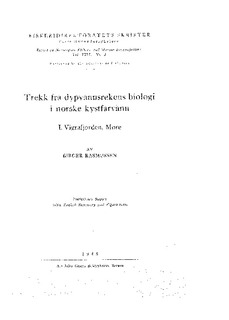| dc.description.abstract | The life history of the deep sea prawn (Pandalus borealis) in the
Vigrafjord on the west coast of Norway is traced on the basis of 8 samples
totaling 4010 specimens collected continuously from September 26.
1943 to May 2. 1944. The material is treated in the same way as mentioned
in a previous work (RASMUSSEN 1942).
A map of the trawling ground in the Vigrafjord is shown in fig.2.
A hydrographic station taken on January 21. 1944 shows that the bottom
is covered by comparatively warm Atlantic water with a temperature
of 7,32° C and salinity 34,33 ‰.
The spawning of the prawn takes place from the middle of September
to the end of October. The eggs hatch the following spring from the
beginning of March till the middle of April, reaching its height about
March 15. The egg-bearing period is estimated to last about 5½ months,
compared with 4½-5 months in the Oslofjord and 9 months at Spitsbergen.
The smallest bottom stages of the prawn measuring averagely
43,5 mm have been captured in the trawl gear at the end of September.
The further growth of the prawn is shown in fig. 4 A-F, black columns.
When one year old the prawns measure 68,5 mm (April 3.) and at an
age of 1½ years they have reached a size of 88 mm (September 26.).
Up to this age the prawns in the Vigrafjord have shown a slower rate
of growth than what is found in the Oslofjord (fig. 5). The majority of
the prawns in the Vigrafjord have become sexually mature and are
functioning males for the first time in their life when 1½ years old.
However, in the material we find some specimens forming an
exception to the rule that they function as males 1½ years old. These
specimens mature instead as females (fig. 4 E-M, white columns).
They are first found in the transitional phase between male and female
(May 2.) and later in fall as ovigerous small prawns measuring averagely
96mm (spawning-group ♀ I). Apparently it is only the largest individuals
of the age-group which become mature egg-bearing females when
only 1½ years old.
Returning to the 1½ years old functioning males their growth is
strongly retarded during the following winter months after breeding.
At the end of December their development takes an unexpected course.
Suddenly the group splits into two fractions, of which one retains
the male characteristics, the other changes into transitional prawns
which later will ripen into females (fig. 6). Again we find that it is the
larger individuals of the age group which become females, while the
smaller prawns remains males. The division is not determined by any
exact size of the prawns, and the fractions will overlap in their size
distribution. It is also found that the rate of growth after the division
is greater in the female group than in the remaining males.
In the course of the summer the female group will become sexually
mature, and in September-October the prawns will be egg-bearing
(spawning-group ♀ II). Thus it is found that a part of the prawn
population become ovigerous for the first time when 2½ years old,
while other individuals of the same age function as males for the second
time. The size of the egg-bearing females is estimated to somewhat
below 130 mm.
The fraction functioning as breeding males for the second time 2½
years old measures 110 mm (September 26.). During the following
winter also these will go over in the transitional stages and by degrees
change into females (fig. 4 M-S). In the fall they will become ovigerous,
thus spawning for the first time as females when 3½ years old. (spawning-
group ♀ III). The size of the individuals at this stage is estimated to
be a little below 130 mm, or the same as in the spawning-group ♀ II.
The population of ovigerous prawns in the Vigrafjord seems mainly
to consist of prawns from spawning-group ♀ II, i.e. 2½ years old first
time spawners (fig. 8). The spawning groups ♀ I and ♀ III, as well
as older spawners, constitute only a small part of the eggbearing prawns.
The material shows that when the prawns are 1¾ years old they
will dominate in the catches, and that prawns of this age may constitute
92 per cent of the catch (fig. 8). As the prawns become older their number
decreases rapidly. The material examined does not, however, contain
strictly commercial catches, as small prawns have been specially taken
care of in sampling.
A schematic picture of the growth and development of the prawn
is shown in fig. 9. | |
